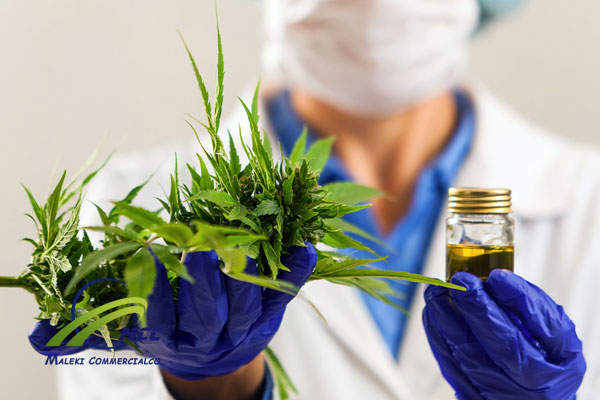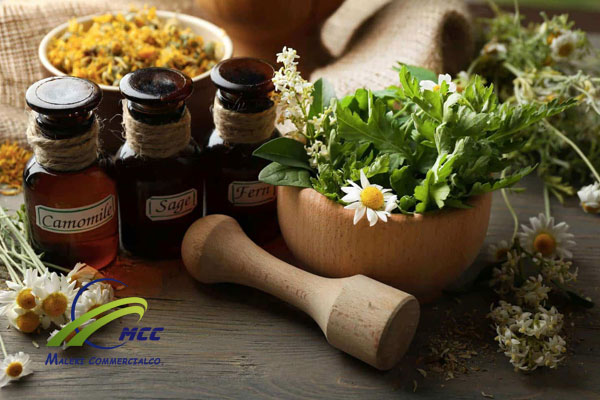Extraction of bioactive compounds and essential oils from medicinal plants
Extraction of medicinal plants: During their growth, plants undergo the synthesis of numerous compounds that accumulate within various plant organs.
These compounds can be extracted, termed secondary metabolites, and a specific subset of these compounds is recognized as essential oils.
What is medicinal plant essential oil?
The essential oils are aromatic compounds dispersed throughout various plant organs. These aromatic compounds are primarily stored within specialized anatomical structures, namely essential oil cells, glands, or secretory ducts within the plant’s anatomy.
Because they tended to evaporate in the air under normal conditions, they are called volatile oils or essential oils.
Characteristics of plant essential oils
- They are colorless and may darken due to oxidation and resinification.
- They are soluble in alcohol; however, these compounds are only slightly soluble in water.
- Some essential oils are exclusively produced as a result of enzymatic reactions within the plant.
- Each essential oil contains a complex composition, often consisting of hundreds of organic compounds. These compounds collectively contribute to the oil’s therapeutic effects, aroma, and distinct fragrance.
- Essential oils can be extracted from various parts of the plant, including flowers, buds, seeds, roots, twigs, wood, and sometimes from all the organs of the plant.
Classification of essential oil compounds
- Alcohols
- Aldehydes
- Oxides
- Esters
- Phenols
- Ketones
- Coumarins
- Monoterpenes
- Cerquiterpenes
Effective substance extraction methods
1- Distillation
2- Cold pressing
3- Solvent extraction
4- Enfleurage extraction
- Vacuum microwave distillation
- Extraction by soaking
Note: Products obtained through extraction are commonly referred to as concentrates, absolutes, ointments, or resins, while oils obtained through distillation or other extraction methods are typically labeled as essential oils.
- Although extraction and distillation refer to the same process of obtaining substances, the term “extraction” is employed in a broader sense to encompass the retrieval of extractable materials such as essential oils and other medicinal and aromatic compounds from plant materials using chemical, physical, and mechanical methods.
Methods of essential oil extraction
The selection of an essential oil extraction method depends on the type of plant, the stored active compounds, and the desired purity level, including:
-
Water distillation
- Water distillation is one of the oldest, most cost-effective, and simplest methods of essential oil extraction.
- This method is typically used for extracting essential oils from plants with hard and firm parts, such as Damask Roses, roots, woods, and nutmeg materials.
- In this method, plant materials are placed inside a distillation vessel, and enough water is added to submerge all the plant materials. The vessel is then heated directly, causing the water to boil
- During this process, the essential oils are released from the surface or interior of the plant material at temperatures below 100°C due to the vaporization process, and they enter water.
- In the subsequent stage, the aromatic compounds, along with water vapor, rise and enter a cooling system where they are condensed and converted into a liquid phase.
- In the subsequent stage, this mixture enters a separator system known as a “Florentine Vessel”. Due to the difference in density between the essential oil and water, these two components are separated from each other.
- The separated distillation liquid, a byproduct commonly known as “Golab” or flower water, must be reintroduced into the distillation system to extract its essential oils.
Disadvantages of the water distillation method
- The plant material is in direct contact with the boiling water. Furthermore, to prevent the accumulation of heavy plant material and to ensure continuous contact with the water, these materials must be stirred within the distillation vessel. However, this stirring can result in excessive heat exposure to the plants, causing a reduction in the quality of the essential oil obtained.
- This method requires skilled labor and a significant number of distillation units.
- Water distillation may not extract all available essential oils from the plant material.
- Essential oils produced using this method tend to be of lower quality compared to other extraction techniques.
- Water distillation is more commonly employed in developing countries.
Water and steam distillation
- Water and steam distillation is a combination of both water and steam distillation methods.
- This method is suitable for both fresh and dried plant materials.
- It is commonly employed for plants such as lemon balm, eucalyptus, thyme, lavender, peppermint, and patchouli. In this process, plant materials are placed inside a distillation vessel on a mesh platform, keeping the plants above the water level. Distillation occurs as the plant materials are exposed to direct heat from steam pipes or other heating mechanisms that are boiling water. The distillation process is facilitated by moist steam at low pressure.
- Uniform placement of dry or wet plant materials in the vessel is essential to ensure consistent steam penetration.
Disadvantages of water and steam distillation
- Plant materials cannot directly contact the heat source at the bottom of the vessel. However, the vessel walls efficiently transfer heat, inadvertently causing overheating of the plant material.
- Moist steam can lead to the accumulation of finer plant materials on the porous surface and may slow down the distillation process.
Note: This method is more time and fuel-efficient compared to simple water distillation and yields a higher quantity of essential oil.
Direct steam distillation
- Direct steam distillation is the most common and preferred method for essential oil extraction.
- Approximately 80% to 90% of essential oil extraction is done using this method.
- This method is primarily used for fresh and moist plant materials.
- Examples of plants commonly subjected to this method include peppermint, German chamomile, and Damask Rose.
- Unlike other methods, no water is present inside the distillation vessel.
- Initially, plant materials are spread on a perforated plate within the distillation vessel. Saturated or very hot dry steam, under high pressure, is then introduced into the vessel underneath the plant materials.
- Steam is generated either separately in a steam generator or by a steam generator apparatus.
- It is essential to uniformly distribute the plant materials inside the vessel to ensure the steam moves through them with the least resistance.
- In the next stage, the steam passes through the plant materials, and as a result of the diffusion process, the essential oil is released from the plant materials.
- The steam, along with a specified quantity of essential oil, rises and enters a cooling section where it is condensed and transformed into a liquid phase. The mixture of water and essential oil is then collected and separated in a Florentine vessel.
Advantages of direct steam distillation
- This method is more suitable and cost-effective for commercial-scale essential oil extraction.
- It is the most cost-efficient method, reducing production costs.
- Approximately 85% of the essential oil present in the plant can be extracted using this method.
- The possibility of pressure adjustment exists within this method, allowing for the application of lower pressure for substances with higher volatility and higher pressure for substances with lower volatility.
- The risk of damage to essential oils containing reactive substances, such as esters, is lower due to the high distillation speed.
- The highest quality of essential oil is obtained through direct steam distillation, and the obtained quality is consistent and reproducible.
Enzymatic extraction
- Enzymatic extraction involves obtaining glucoside essential oils through enzymatic hydrolysis, as seen in bitter almond and mustard seed essential oils.
- In the case of bitter almonds, various compounds are produced due to emulsion acting on amygdalin. Among these compounds, essential oils can be separately extracted using distillation.
Normal heat compression
- Some essential oils, such as lemon and bergamot, decompose during distillation, necessitating the use of mechanical methods to separate them.
- One of these methods involves rupturing the oil glands by rubbing fruit on surfaces equipped with sharp blades that penetrate only the epidermal layer. The resulting essential oil droplets entered the container and were then collected.
Solvent extraction
- Solvent extraction is used when essential oils are scarce in plant petals and extracting them by other methods is difficult.
- For this method, an odorless liquid oil is placed in a shallow glass dish, and the petals are placed inside the dish for several hours. Fresh petals may be added again.
- After saturation, the essential oil can be separated from the oil using alcohol.
- This method was previously used for perfume and ointment production.
- In the fragrance industry, a significant portion of essential oils is obtained using solvent extraction methods, employing non-polar solvents such as petroleum, benzene, and ether. For this purpose, the raw plant material is placed in proximity to a non-polar solvent at a temperature ranging from 40 to 50 °C. The duration of the plant material’s exposure to the solvent depends on the specific type of plant material, the type of solvent used, and the condition of the plant material.
- The solvent used primarily dissolves the majority of the active compounds present in the plant.
- In the subsequent stage, the solution is distilled to purify it and remove the solvent. The resulting solution, known as “concrete,” contains not only aromatic compounds but also waxes and plant pigments, which may require further purification when necessary.
- For purification, initially, the concrete is mixed with methyl or ethyl alcohol and heated to dissolve the aromatic active compounds in the alcohol. The resulting solution is filtered to separate the waxes. Subsequently, the alcohol solution is distilled under relative vacuum conditions to remove the solvent, resulting in the obtainment of pure essential oil.
Extraction using gases
- This method is a newer distillation technique based on the use of CO2 gas at its critical point.
- Carbon dioxide, in its liquid state, can dissolve aromatic compounds and forms two phases in a gaseous state.
- Approximately in the critical point, the essential oil extraction process involves two alternating factors, including 1- Compression, during which carbon dioxide becomes liquid and dissolves the aromatic compounds. 2- Expansion, accompanied by the transition of carbon dioxide from a liquid to a gaseous state. Simultaneously, the essential oils are separated from the aromatic materials.
Fractional distillation
- Fractional distillation is used to obtain oils with an empyreumatic odor.
- When wood or resins from the pine family are heated under anaerobic conditions, multiple volatile compounds are produced. The remaining mass will be charcoal, and the distilled aromatic materials are divided into two layers: a watery layer containing methyl alcohol, pyroligneous acid (impure acetic acid), and other dark-colored layer containing pine tar materials and other compounds. The composition of this layer depends on the type of wood used.
- This dry distillation is usually carried out in sealed pots. If the used wood is finely ground or milled, or if heat is applied rapidly, the amount of tar obtained can be as high as 10% of the wood used.

